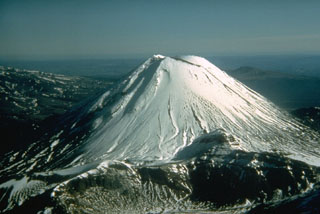Report on Tongariro (New Zealand) — 21 November-27 November 2012
Smithsonian Institution / US Geological Survey
Weekly Volcanic Activity Report, 21 November-27 November 2012
Managing Editor: Sally Sennert.
Please cite this report as:
Global Volcanism Program, 2012. Report on Tongariro (New Zealand) (Sennert, S, ed.). Weekly Volcanic Activity Report, 21 November-27 November 2012. Smithsonian Institution and US Geological Survey.
Tongariro
New Zealand
39.157°S, 175.632°E; summit elev. 1978 m
All times are local (unless otherwise noted)
A small eruption at Tongariro's Te Maari Craters occurred at 1325 on 21 November, without precursory events, prompting GeoNet to raise the Volcanic Alert Level to 2 and the Aviation Colour Code to Red. A report at 1730 noted that the eruption appeared to be over; the Aviation Colour Code was lowered to Orange.
The eruption occurred in the same area as the previous eruption on 6 August and lasted less than five minutes, although local seismic activity lasted about 15 minutes. GNS staff and hikers saw the eruption. An ash plume rose 3-4 km above the Upper Te Maari crater and produced ashfall across part of State Highway 46 and NE towards Turangi (21 km NE). Two small pyroclastic density currents were produced at the base of the column, to the W and N of the crater, and traveled a limited distance of a few hundred meters downslope. Later that afternoon gas-and-steam plumes drifted SE. On 22 November a sulfur gas odor was reported in Manawatu (S) and Hawke's Bay (115 km ESE), downwind of Tongariro. A substantial amount of gas was emitted during 22-23 November. The Aviation Colour Code was lowered to Yellow on 23 November due to the absence of emitted ash. On 26 November GeoNet noted that no further volcanic activity had occurred since the eruption, gas flux had decreased, and seismic activity remained low.
Geological Summary. Tongariro is a large volcanic massif, located immediately NE of Ruapehu volcano, that is composed of more than a dozen composite cones constructed over a period of 275,000 years. Vents along a NE-trending zone extending from Saddle Cone (below Ruapehu) to Te Maari crater (including vents at the present-day location of Ngauruhoe) were active during several hundred years around 10,000 years ago, producing the largest known eruptions at the Tongariro complex during the Holocene. North Crater stratovolcano is truncated by a broad, shallow crater filled by a solidified lava lake that is cut on the NW side by a small explosion crater. The youngest cone, Ngauruhoe, is also the highest peak.
Source: GeoNet

